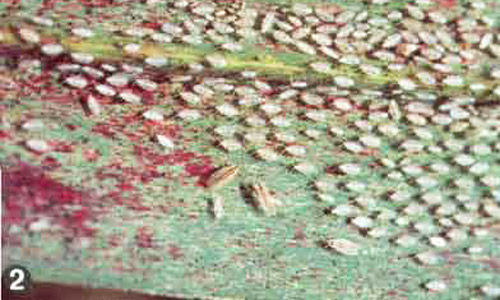common name: sugarcane lace bug
scientific name: Leptodictya tabida (Herrich-Schaeffer) (Insecta: Hemiptera: Tingidae)
Introduction - Distribution - Description - Biology and Host Plants - Natural Enemies - Selected References
Introduction (Back to Top)
The sugarcane lace bug was first described by Herrich-Schaeffer as Monanthia tabida from specimens collected in Mexico in 1839 and synonymized as Leptodictya tabida (Herrich- Schaeffer) by Champion in 1900 (Heidemann 1913). It was discovered on sugarcane, Saccharum officinarum L. in Palm Beach County, Florida, in July, 1990. A survey conducted shortly after the discovery of this pest in Florida showed that many sugarcane fields in Palm Beach, Hendry and Collier counties were infested with Leptodictya tabida. Several hundred acres of sugarcane in Palm Beach County displayed red russeting, with more than 100 adults and nymphs of Leptodictya tabida found on some leaves (Hall 1990, 1991). This insect could become a major pest of sugarcane in Florida, perhaps more so during dry years.
Figure 1. Sugarcane russeted by the sugarcane lace bug, Leptodictya tabida (Herrich-Schaeffer). Photograph by Division of Plant Industry.
Distribution (Back to Top)
The sugarcane lace bug occurs in numerous countries including Costa Rica, Cuba, El Salvador, Guatemala, Honduras, Mexico, Nicaragua, Panama, Venezuela and the United States (Hawaii, Texas and Florida) (Chang and Ota 1986, Hall 1991, Metcalfe 1966).
Description (Back to Top)
Adult oblong, flat, length 3.8 mm, width across the widest part of elytra 1.6 mm. Head short with five slender spines. Eyes small, globular, reddish and strongly faceted. Antennae yellowish, long and thin. Pronotum narrowed anteriorly, the disk barely convex, with three linear, low carinae, interspaces finely punctured. The elytra are transparent, elongate oval in shape, and extend far beyond the abdomen.
Figure 2. Adult and nymph of the sugarcane lace bug, Leptodictya tabida (Herrich- Schaeffer). Photograph by Division of Plant Industry.
The nymph is different from adult in appearance. The nymph is oblong, rather flat, yellowish and densely covered with erect white spinules (Heidemann 1913).
Figure 3. A colony of sugarcane lace bug, Leptodictya tabida (Herrich- Schaeffer), nymphs on a sugarcane leaf. Photograph by Division of Plant Industry.
Biology and Host Plants (Back to Top)
This lace bug completes a generation from egg to adult in 20 to 30 days during the summer in Hawaii (Chang 1985). Under laboratory conditions of 27 °C in Gainesville, Florida, the egg stage lasted 16 to 20 days. The nymphs molt five times and mature in about 15 days. Eggs are very small and are deposited into paraenchyma cells on the underside of the leaf (Chang 1985). According to Chang 1985, the sugarcane lace bug has been reported on corn, Zea mays L.; Guinea grass, Panicum maximum Jacq.; Johnson grass, Sorghum halepense (L.) Pers.; barnyard grass, Echinochloa crus-galli (L.) Beauvois; bamboo; sugarcane, Sorghum officinarum and teosinte, Zea mexicana (Schrad.) Kuntze.
Figure 4. Eggs of the sugarcane lace bug, Leptodictya tabida (Herrich-Schaeffer). Photograph by Division of Plant Industry.
Natural Enemies (Back to Top)
Natural enemies of Leptodictya tabida have not been intensively studied and only Coleomegilla maculata (DeGeer) (Coleoptera: Coccinellidae) was listed as its predator (Chang 1985). During a trip to Central and South America in 1986, Hawaii Department of Agriculture Entomologist, Marianna Early, found eggs of Leptodictya. tabida were parasitized by Erythmelus sp. in Costa Rica and Venezuela (M. Early, unpublished report 1986). An attempt to introduce this parasite from Venezuela to Florida was done by F.D. Bennett, D.G. Hall and Ru Nguyen in May 1991. However, it was not successful. The F1 generation was produced in the Quarantine Laboratory in Gainesville but no F2 progeny were obtained.
Selected References (Back to Top)
- Chang VCS. 1985. The sugarcane lace bug: a new insect pest in Hawaii. Annual Confrence Report, Hawaiian Sugar Technology 44: A27-A29.
- Chang VCS, Ota AK. 1986. The sugarcane lacebug. Experiment Station Annual Report, Hawaiian Sugar Planter's Association 24-26.
- Early M. 1986. Report on an exploratory trip to Costa Rica, Panama, Venezuela and Brazil. February 10-April 22, 1986. Hawaii Department of Agriculture unpublished report. 21 pp.
- Hall DG. 1990. The sugarcane lace bug, an insect pest new to Florida. Sugar Journal 53: 10-11.
- Hall DG. 1991. Sugarcane lace bug Leptodictya tabida, an insect pest new to Florida. Florida Entomologist 74: 148-149.
- Heidemann O. 1913. The sugar-cane tingid from Mexico. Journal of Economic Entomology 6: 249-251.
- Metcalfe JR. 1966. Report on a visit to study canefly (Saccharosydne saccharivora) (Westw.) in British Honduras, 14th April to 3rd May, 1966. Tech. Bull. Sug. Mfrs. Asso. Jamaica Entomol. No. 2/66, 9 pp. Abstract in the Review of Applied Entomology Series A 56: 1399.
